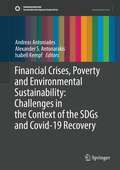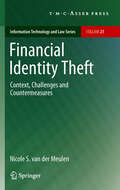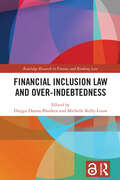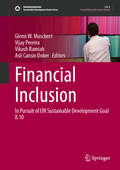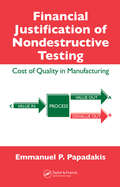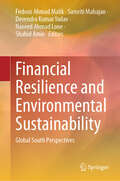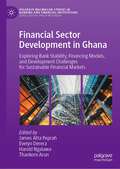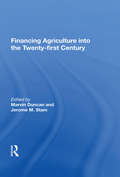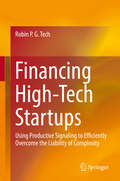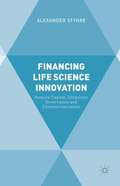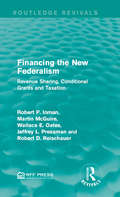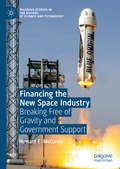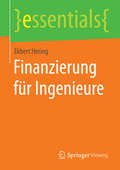- Table View
- List View
Final Frontier: The Pioneering Science and Technology of Exploring the Universe
by Brian CleggStar Trek was right — there is only one final frontier, and that is space...Human beings are natural explorers, and nowhere is this frontier spirit stronger than in the United States of America. It almost defines the character of the US. But the Earth is running out of frontiers fast.In Brian Clegg's The Final Frontier we discover the massive challenges that face explorers, both human and robotic, to uncover the current and future technologies that could take us out into the galaxy and take a voyage of discovery where no one has gone before… but one day someone will. In 2003, General Wesley Clark set the nation a challenge to produce the technology that would enable new pioneers to explore the galaxy. That challenge is tough — the greatest we've ever faced. But taking on the final frontier does not have to be a fantasy.In a time of recession, escapism is always popular — and what greater escape from the everyday can there be than the chance of leaving Earth's bounds and exploring the universe? With a rich popular culture heritage in science fiction movies, books and TV shows, this is a subject that entertains and informs in equal measure.
Final Report of the Committee on a Strategic Plan for U.S. Burning Plasma Research
by Engineering Medicine National Academies of SciencesFusion offers the prospect of virtually unlimited energy. The United States and many nations around the world have made enormous progress toward achieving fusion energy. With ITER scheduled to go online within a decade and demonstrate controlled fusion ten years later, now is the right time for the United States to develop plans to benefit from its investment in burning plasma research and take steps to develop fusion electricity for the nation’s future energy needs. At the request of the Department of Energy, the National Academies of Sciences, Engineering, and Medicine organized a committee to develop a strategic plan for U.S. fusion research. The final report’s two main recommendations are: (1) The United States should remain an ITER partner as the most cost-effective way to gain experience with a burning plasma at the scale of a power plant. (2) The United States should start a national program of accompanying research and technology leading to the construction of a compact pilot plant that produces electricity from fusion at the lowest possible capital cost.
Finance and Accounting for Energy Engineers: & Engineers in All Disciplines (River Publishers Series in Energy Management)
by S. Bobby RaufThe purpose of this second edition is to provide an overview of important principles in the fields of finance and accounting, and the application of those principles for financial analysis of energy and non-energy capital investments. This book is written as a self-study guide for energy and non-energy engineers and managers who either lack formal training in the subjects of finance, accounting, and engineering economics, or simply need a means to refresh their knowledge in these subjects. This book bridges the gap between the typical business school "MBA" knowledge and its application in enery and non-engergy engineering, project management or manufacturing management. Many energy and non-energy engineers and technical managers feel inadequately equipped to comprehend and apply certain important finance and accounting principles. Understanding of finance and accounting principles is important in interfacing and conducting business with accountants, financial analysts, and members of upper management. This book is designed to familiarize energy engineers and other engineering professionals - in a relatively simple and easy to understand fashion - with decision making skills founded on financial calculations and case study based quantitative analysis.
Financial Crimes and Existential Philosophy
by Michel DionThe aim of this book is to deepen our understanding of financial crimes as phenomena. It uses concepts of existential philosophies that are relevant to dissecting the phenomenon of financial crimes. With the help of these concepts, the book makes clear what the impact of financial crimes is on the way a human being defines himself or the way he focuses on a given notion of humankind. The book unveils how the growth of financial crimes has contributed to the increase of the anthropological gap, and how the phenomenon of financial crimes now distorts the way we understand humankind. Using the existential philosophies of Kierkegaard, Nietzsche, Jaspers, Buber, Heidegger, and Marcel, the book sheds light on how these philosophies can help to better perceive and describe financial crimes. Next it looks at prevention strategies from an organizational perspective, using concepts of Sartre, Gadamer and Tillich. The book provides readers with existential principles that will help them be more efficient when they have to design and implement prevention strategies against corporate crime.
Financial Crimes: A Threat to Global Security
by Maximillian Edelbacher, Peter Kratcoski and Michael TheilFinancial market reform has focused chiefly on the threats to stability arising from the risky, uncontrolled activity of the leaders of financial institutions. Nevertheless, organized crime, white-collar crime, and corruption have a huge impact on financial systems worldwide and must also be confronted if true reform is to be achieved. A collection
Financial Crimes: A Threat to Global Security (Advances in Police Theory and Practice)
by Peter Kratcoski Michael Theil Maximillian EdelbacherFinancial market reform has focused chiefly on the threats to stability arising from the risky, uncontrolled activity of the leaders of financial institutions. Nevertheless, organized crime, white-collar crime, and corruption have a huge impact on financial systems worldwide and must also be confronted if true reform is to be achieved. A collection
Financial Crises, Poverty and Environmental Sustainability: Challenges in the Context of the SDGs and Covid-19 Recovery (Sustainable Development Goals Series)
by Andreas Antoniades Alexander S. Antonarakis Isabell KempfThis volume advances the state-of-the-art in the study of the interplay among financial crises, poverty dynamics and environmental sustainability. It offers timely and unique contributions to the immediate global challenge of sustainable development. Developing a new evidence-base, the volume offers concrete recommendations for policy action needed in advancing the Sustainable Development Goals (SDGs) in relation to environment and poverty during the current conditions of financial distress. The approach taken is inductive and evidence-driven. Most analysis is based on in-depth case studies that aim to offer a detailed and dynamic picture on how poverty and environmental sustainability interact in specific social contexts and financial crises. In this way the volume aims to generate a wealth of new and concrete evidence that offer a solid foundation to understand the multiple channels through which social and environmental factors interact, and the ways in which this interaction can and should be managed in order to achieve the needed global transition to sustainability. Broader dynamics that are covered and analysed include the historical legacies of structural adjustment and colonialism; the current debt wave experienced in developing countries; the role of inequality; the significant impact that climate change has on livelihoods and on meeting the SDGs; the new challenge presented by the Covid-19 pandemic for the SDGs; the challenge of sustainable funding for SDGs; and the need for a new eco-social contract. Case-studies examined include Cambodia, Ethiopia, India, Indonesia, Zambia, and subregions such as the Caribbean, sub-Saharan Africa and Lower Mekong Countries. The volume is part of a joint initiative by the ‘Sussex Sustainability Research Programme (SSRP)’ of the University of Sussex, the ‘UNDP-UNEP Poverty-Environment Action for Sustainable Development Goals’ and the ‘United Nations Research Institute for Social Development (UNRISD)’. The overall aim is to advance a new research programme and foster a better understanding of the multiple, complex and often opposing ways through which the punctuated economic slowdown of financial crises, poverty dynamics and environmental sustainability interact. It also makes novel recommendations into how poverty reduction and environment can work in synergy rather than being antagonistic, especially during financial distress, leading into recommendations directly geared towards achieving the SDGs and beyond.
Financial Identity Theft
by Nicole S. van der MeulenThe existence of financial identity theft in the United States, and its (gradual) spread to other areas of the world, increases the need to understand how identity theft occurs and how perpetrators of the crime manage to take advantage of developments within contemporary society. This book aims to provide such an understanding through an in-depth comparative analysis which illustrates how states, financial service providers, consumers, and others facilitate the occurrence of financial identity theft in the United States and the Netherlands.
Financial Inclusion Law and Over-Indebtedness (Routledge Research in Finance and Banking Law)
by Michelle Kelly-Louw Duygu Damar-BlankenThe book addresses the current challenges faced by financial consumers in the context of enormous technological developments. This edited collection covers safeguarding financial consumers, encompassing topics such as financial inclusion, data protection, and consumer over-indebtedness. Addressing specific issues related to vulnerable consumer groups and the increasing digitisation of financial services, it grapples with the emerging challenge demanding that consumers possess technological literacy.The book offers a distinct new perspective, going beyond the traditional understanding of financial inclusion, which typically only considers the possession of a bank account. Instead, it explores new dimensions, including the obstacles consumers face in obtaining credit, establishing a credit history, and coping with issues such as being blacklisted. The book explores diverse strategies for enhancing financial inclusion, such as leveraging data, and open banking. It also scrutinises the pursuit of credit fairness and examines methods to either mitigate or effectively address over-indebtedness, a persistent and formidable challenge for financial consumers.The book will be of interest to researchers, practitioners, and governmental organisations in the field of finance law and the law of emerging technologies.Chapter 2 of this book is freely available as a downloadable Open Access PDF at http://www.taylorfrancis.com under a Creative Commons Attribution-Non Commercial-No Derivatives (CC-BY-NC-ND) 4.0 International license.
Financial Inclusion: In Pursuit of UN Sustainable Development Goal 8.10 (Sustainable Development Goals Series)
by Vijay Pereira Vikash Ramiah Glenn W. Muschert Asli Cansin DokerThis volume presents an academic discussion of SDG sub-goal 8.10, which involves increasing financial inclusion via enhancing access to banking, insurance, and other financial services. It examines the challenges that prevent many from accessing financial services and analyses strategies governments, financial institutions, and NGOs can use to promote broader financial inclusion. It also explores economic, sociological, financial, and other social sciences/business perspectives on SDG 8.10 and its key indicators. Featuring global and regional topics and country studies, this volume provides an interdisciplinary approach to financial inclusion that informs, inspires, and catalyzes action for a more inclusive and sustainable global economy.
Financial Justification of Nondestructive Testing: Cost of Quality in Manufacturing
by Emmanuel P. PapadakisDemonstrating how to apply financial formulas to prove or disprove the utility of 100% Nondesctructive testing (NDT), this book helps readers build the financial case for their NDT projects. It not only explains how 100% inspection by high-tech methods can save money for a manufacturing organization, but also how to justify this cost. Providing examples of successful NDT implementation drawn from factory situations, the author describes high-tech inspection technology in the context of modern ISO Quality Standards, TQM theory, and Statistical Process Control. Placing NDT in the historical context of quality and inspection, the book provides three methods of calculation for proving its validity.
Financial Resilience and Environmental Sustainability: Global South Perspectives
by Shahid Amin Firdous Ahmad Malik Samriti Mahajan Devendra Kumar Yadav Naveed Ahmad LoneThis book offers a thorough examination of financial resilience and environmental sustainability, focusing on the financing of environmental sustainability, and addressing the issues, challenges, and opportunities of green financing alongside sustainable development. It presents global South perspectives on the critical issues of financing and environmental sustainability, providing policy recommendations for economies grappling with these paradoxical concerns. This book explores the challenges of financing and environmental sustainability through insights from various emerging economies. It combines theoretical, empirical, and model-based evidence to address the sustainability challenges faced by global economies, aligning with sustainable development goals. The book investigates climate change and environmental degradation challenges and examines economic strategies for a sustainable future. With over one billion people living below the poverty line, many lacking access to financial products and services, this book aims to present practical examples of financial inclusion, using the sustainable development goals as a framework. The book illustrates that comprehensive financial inclusion goes beyond credit access and bank account services, addressing the need for financially viable and accessible products and services that meet individuals' financial needs and vulnerabilities. It demonstrates how inclusive financial systems can empower those living in poverty globally, improving income levels, employment opportunities, livelihoods, and ultimately reducing poverty.
Financial Sector Development in Ghana: Exploring Bank Stability, Financing Models, and Development Challenges for Sustainable Financial Markets (Palgrave Macmillan Studies in Banking and Financial Institutions)
by Thankom Arun James Atta Peprah Evelyn Derera Harold NgalawaThis book investigates factors that contribute to the development of an efficient financial sector in Ghana. While sustainable finance has long been known to propel economic growth and development, and while many African countries have taken initiatives to develop integrated frameworks of their financial sectors that tackle developmental challenges, scholars and policymakers have always grappled with understanding of factors that enhance performance of the financial sector. In this book, an expert team of authors examines the financial landscape, central bank policies, competition, financial innovation, financial inclusion and banking stability in Ghana, while also exploring how financing models such as enterprise finance and microfinance can be more effective in sustaining financial markets. The authors discuss how Ghana can build fortified institutions, regulatory frameworks, and productive capacity to strengthen the financial sector and foster pathways that will enhance economic development. Empirical and scientific evidence give this book a unique approach that is both qualitative and quantitative.
Financing Agriculture Into The Twenty-first Century
by Marvin DuncanThis volume is concerned with the paradigm shifts occurring in U.S. agriculture and its related financial services sector. The U.S. agricultural sector is undergoing rapid change with large segments commonly described as industrialized. Often observers focus on the technological and structural changes that the sector is undergoing and ignore other
Financing Energy Efficiency: Lessons from Brazil, China, India, and Beyond
by Jeremy Levin Chandrasekar Govindarajalu Anke S. Meyer Robert P. Taylor William A. WardWhile energy efficiency projects could partly meet new energy demand more cheaply than new supplies, weak economic institutions in developing and transitional economies impede developing and financing energy efficiency retrofits. This book analyzes these difficulties, suggests a 3-part model for projectizing and financing energy efficiency retrofits, and presents thirteen case studies to illustrate the issues and principles involved.
Financing High-Tech Startups: Using Productive Signaling To Efficiently Overcome The Liability Of Complexity
by Robin P. TechThis book examines the adverse effects of complexity, information asymmetries, transaction costs, and uncertainty on investors’ decision making. It suggests mitigating those effects using appropriate and matching signals, and analyzes a sample of 903 German startups to quantitatively highlight the distinct financing patterns and characteristics of high-tech startups. It then investigates the reasons for these patterns on the basis of a qualitative study that includes 34 interviews with investors and entrepreneurs in the US and Germany and an international expert panel. Lastly, it presents a framework that matches complexity factors with appropriate productive signals.
Financing Life Science Innovation
by Alexander StyhreThe life sciences are widely treated as a field and an industry with high-growth potential, and while neoclassical economic theory prescribes that capital are invested in emerging industries, there is a perceived shortage of venture capital among life science entrepreneurs. Financing Life Science Innovation reviews the literature on venture capital, corporate governance, and life science venturing and presents a study of the Swedish life science industry and the venture capital investors being active in financially and managerially supporting life science start-up firms. The study reveals that venture capital investors, life science entrepreneurs, and innovation system actors today face the challenge of supplying adequate amounts of capital to an industry that may produce tomorrow's health care innovations. Changes in scientific research practices, the structure of the international finance market, and industry policy are all contributing to what is frequently treated as a shortage of venture capital in the life sciences.
Financing Sustainable Development: Key Challenges and Prospects (Palgrave Studies in Impact Finance)
by Bruno S. Sergi Magdalena ZioloThis book is among the first to address the issue of assessing the efficiency of sustainable development financing from a theoretical and methodical point of view. The innovative nature of research is expressed through the study of new phenomena in finance including sustainable financial systems, sustainable finance, ESG risk and individual and institutional motivations of financial managers in the sustainability concept. The book aims to draw attention to the significant gap in the existing research.The concept of Sustainable Development, if placed in an economic category, requires a lot of attention, but seeing the cognitive category from the perspective of the discipline of finance, the latter is unsatisfactory, with questions remaining unanswered. At the same time, the rank problem, its strategic dimension and the amount of financial resources allocated and disbursed for the purposes of focusing around sustainable development, identification of financial phenomena accompanying this category is seen as a priority. Most measures financing Sustainable Development and measures of public spending efficiency are measures subject to rigor and rules due to their specificity, which means actions aimed at increasing efficiency are treated as a priority. This book will be of interest to leading representatives of academia, practitioners, executives, officials, and graduate students in economics, finance, management, statistics, law and political sciences.
Financing The Agricultural Sector: Future Challenges And Policy Alternatives
by Dean W. HughesFarm credit and tax policies have become increasingly important areas of concern for policymakers and agriculturists. Rising levels of debt use among the nation's commercial producers, rising interest rates, and an increased dependence on international commodity markets have contributed to greater income volatility at the farm level, making financi
Financing for Low-carbon Energy Transition: Unlocking the Potential of Private Capital
by Venkatachalam Anbumozhi Kaliappa Kalirajan Fukunari KimuraThis book is the first comprehensive assessment of the state of low-carbon investments in Asia, analyzing the rationales, mandates and public–private financing activities. Based on the experiences of several regional initiatives wherein public financing is catalyzing private investments in low-carbon infrastructure, this book proposes a framework that can be used as a tool to identify factors that influence private investment decisions and policy instruments that can scale up the private capital.Placing the Asian economies onto a low-carbon development pathway requires an unprecedented shift in investments. This book addresses this situation by asking questions such as: • What is the central role of private finance in achieving the Paris Agreement targets? • What key policy levers and risk mitigation can governments use in an effort to unlock the potentials of private capital? • How can regionally coordinated actions hold significant promise for scaling up private investments?
Financing the New Federalism: Revenue Sharing, Conditional Grants and Taxation (Routledge Revivals)
by Jeffrey L. Pressman Wallace E. Oates Robert P. Inman Martin McGuire Robert D. ReischauerFinancing the New Federalism is the fifth in a series on the governance of metropolitan areas which aimed to improve the political organisation of metropolitan regions in America. Originally published in 1975, this particular study focusses on federal revenue sharing exploring its effects and implications with the purpose of providing a breadth of views on the subject for policy-makers. This title will be of interest to students of environmental studies.
Financing the New Space Industry: Breaking Free of Gravity and Government Support (Palgrave Studies in the History of Science and Technology)
by Howard E. McCurdyThis Palgrave Pivot investigates the efforts of five aerospace companies—SpaceX, Blue Origin, Virgin Galactic, Orbital Sciences, and the Boeing Company—to launch their entry into the field of commercial space transportation. Can private sector firms raise enough capital to end the usual dependence on government funding? What can historical examples of other large-scale transportation initiatives, such as the first transcontinental railway and the first commercial jetliner, teach us about the prospects of commercial space flight? As Howard E. McCurdy shows, commercializing space is a great experiment, the outcome of which will depend on whether new space entrepreneurs can attract support from a variety of traditional and nontraditional sources.
Financing the Race to Space: How to Value, Invest, and Explore the Universe
by Armen V. PapazianThis book examines the monetary and financial foundations for actively pursuing outer space exploration, development, and settlement. It offers the keys to unlocking the massive investment programs needed to invent, manufacture, deploy, and maintain the new habitats of the future. The book discusses what is currently holding us back and how we can transcend our limitations. It addresses the shortcomings of our financial value framework, financial mathematics, and monetary architecture and introduces the key transformations necessary to unleash our spatial potential. An unprecedented discussion at the intersection of finance and outer space, it is a must-read for policymakers, industry leaders, entrepreneurs, bankers, and investors.
Finanzierung für Ingenieure (essentials)
by Ekbert HeringDie meisten Ingenieure in der Praxis werden vor Finanzierungsaufgaben gestellt und müssen hierfür die optimalen Finanzierungsmöglichkeiten bereitstellen. Deshalb werden in diesem Band die Finanzierungsarten und die Finanzierungsinstrumente vorgestellt. Es wird gezeigt, welche wichtigen Informationen eine Finanzanalyse bieten kann und wie eine Finanzplanung für ein Unternehmen erstellt wird.
Find More Birds: 111 Surprising Ways To Spot Birds Wherever You Are
by Heather Wolf“Packed with excellent photos and tips, deeply relatable anecdotes, and a palpable sense of joy, this gem of a book will make you a better birder.”—Rosemary Mosco, author of A Pocket Guide to Pigeon Watching A gorgeously photographed trove of 111 ingenious tips for seeing more birds wherever you are—from crowd favorites (hummingbirds, owls, eagles) to species you’ve never spotted before Seeing more birds than you ever imagined and witnessing exciting avian drama is possible—whether you’re on the go or in your own neighborhood, local park, or backyard. As Heather Wolf explains, it all comes down to how you tune in to the show happening around you, the one in which birds—highly skilled at staying under the radar—are the stars. In Find More Birds, Heather shares her very best tactics—and the jaw-dropping photographs they helped her capture. Look for birds at their favorite “restaurants”— from leaf litter to berry bushes, and ball fields to small patches of mud. Watch for “tree bark” that moves . . . you may find it has feathers. Try simply sitting on the ground for a revealing new perspective. Plus, special tips point the way to crowd favorites such as hummingbirds, owls, and eagles—and can’t-miss bird behaviors. As your senses sharpen and “noticing” becomes second nature, Find More Birds will turn your daily routines into bird-finding adventures, too. Whether you’re strolling down the block or parking your car, you never know what will surprise you next!





